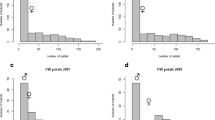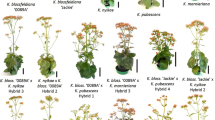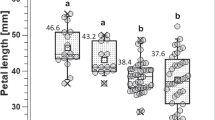Abstract
Nine divergent popular hybrid rose cultivars and 22 of their F1 hybrids were studied to determine the extent of crossability and heterosis effects for several quantitative and qualitative traits in the climatic conditions of Faisalabad, Pakistan. The percentage of pollen germination differed across cultivars. Gruss-an-Teplitz exhibited the maximum value for pollen germination (46.5%), followed by Autumn Sunset (38.9%). Iceberg, being triploid, presented the lowest percentage of germination. All cultivars exhibited a strong correlation between pollen germination percentages in the lab and crossing success under field conditions. The cultivar Handel showed remarkable fruit-set and crossing success. In contrast, the cultivar Iceberg exhibited very poor crossing success rates. The setting of hips after crossing was maximal in the crosses Handel × Louise Odier and Autumn Sunset × Casino (83% each). The number of seeds in a single hip varied among cultivars. The potential for heterotic and heterobeltiotic was also variable and showed contrasting performance between F1 progenies for various qualitative and quantitative traits. The parent cultivars and progenies were sorted into five major groups by cluster analysis based on phenotypic variation. Phenotypic and genotypic coefficients of variability and heritability percentages varied among all parent cultivars for all morphological traits.
Similar content being viewed by others
Literature Cited
Bell, R.J. 1988. Amateurs rose breeder’s guide: complete instructions on how to breed new varieties of roses, Harkaway, Victoria.
Bo, J., D. Huiru, and Y. Xiaohan. 1995. Shortening hybridization breeding cycle of rose — a study on mechanisms controlling achene dormancy. Acta Hortic. 404:40–47.
Burton, G.W. and E. H. DeVane. 1953. Estimating heritability in tall fescue from replicated clonal material. Agron. J. 45:478–481.
Debener, T. 1999. Genetic analysis of horticulturally important morphological and physiological characters in diploid roses. Gartenbauwissenschaft 64:14–20.
Debener, T. 2003. Genetics: Inheritance of characteristics. p. 286–292, In: Roberts AV, Debener T, and Gudin S (eds). Encyclopedia of rose science, Elsevier, Academic Press, Oxford.
Densmore, R. and J.C. Zasada. 1977. Germination requirements of Alaskan Rosa acicularis. Can. Field-Nat. 91:58–62.
De Vries, D.P. 1976. Juvenility in hybrid tea-roses. Euphytica 25:321–328.
De Vries, D.P and L.A.M. Dubois. 1996. Rose breeding: past, present, prospects. Acta Hortic. 424:241–248.
De Vries, D.P. and L.A.M. Dubois. 1983. Pollen and pollination experiments-X. The effect of repeated pollination on fruit and seed set in crosses between the hybrid tea-rose cvs. Sonia and Ilona. Euphytica 32:685–689.
De Vries, D.P. and L.A.M. Dubois. 1987. The effect of temperature on fruit set, seed set and seed germination in Sonia×Hadley hybrid tea-rose crosses. Euphytica 36:117–120.
De Vries, D.P., F. Garretsen, L.A.M. Dubois, and H.A. van Keulen. 1980. Breeding research on rose pigments. II. Combining ability analyses of variance of four flavonoids in F1 populations. Euphytica 29:115–120.
Fagerlind, F. 1954. Influence of the pollen-giver on the production of hips, achenes and seeds in the ‘Canina Roses’. Acta Hortic. Bergiani. 16:121–168.
Farooq, A., M.A. Khan, A. Riaz, A. Younis, S.J. Butt and M. Nadeem. 2013. Compatibility evaluation of various scented Rosa species through cross pollination. Int. J. Basic Appl. Sci. 13:21–27.
Ferrante, A., A. Trivellini, and G. Serra. 2010. Color intensity and flower longevity of garden roses. Res. J. Bio. Sci. 5:125–130.
Fonseca, S. and F.L. Patterson. 1968. Hybrid vigor in seven parental diallel cross in common winter wheat (Triticum aestivum L.). Crop Sci. 8:85–88.
Forkmann, G. 1991. Flavonoid as flower pigments: The formation of the natural spectrum and its extension by genetic engineering. Plant Breed. 106:1–26.
Gudin, S. 1992. Influence of bud chilling on subsequent reproductive fertility in roses. Sci. Hortic. 51:139–144.
Gudin, S. 2000. Rose: genetics and breeding. Plant Breed. Rev. 17:159–189.
Gudin, S., L. Arene, and A.B.C. Chavagnat. 1990. Influence of endocarp thickness on rose achene germination: genetic and environmental factors. Hortic. Sci. 25:786–788.
Gudin, S., L. Arene, and C. Bulard. 1991. Influence of season on rose pollen quality. Sex Plant Reprod. 4:113–117.
Islam, A.A.M., N. Anuar, Z. Yaakob, and M. Osman. 2011. Heterosis for seed yield and its component in Jatropha (Jatropha curcas L.). Int. J. Plant Breed. 5:74–79.
Khan, M.A. 1988. Studies on the compatibility of six hybrid tea roses. Pak. J. Agric. Sci. 23:73–78.
Manjula, G.M. 2005. Performance of rose cultivars under naturally ventilated polyhouse. MSc Thesis, University of Agricultural Sciences, Dharwad, India.
Moe, R. 1988. Growth and flowering in roses. Acta Hortic. 218: 121–129.
Morey, D. 1959. Observations on the genetics of doubleness in roses. Am. Rose Ann. 44:113–116.
Nadeem, M., M.A. Khan, A. Riaz, and A. Rashid. 2011. Evaluation of growth and flowering potential of Rosa hybrida cultivars under Faisalabad climatic conditions. Pak. J. Agric. Sci. 48:283–288.
Ogilvie, I., D. Cloutier, N. Arnold, and P.Y. Jui. 1991. The effect of gibberellic acid on fruit and seed set in crosses of garden and winter hardy Rosa accessions. Euphytica 52:119–123.
Patil, L.C., R.R. Hanchinal, H.C. Lohithaswa, H.L. Nadaf, I.K. Kalappanavar, and S.M. Megere. 2011. Heterosis studies in interspecific hybridization [Triticum dicoccum (Schran) Schulb x Triticum durum Desf] of tetraploid wheat. Karnataka J. Agric. Sci. 24:387–389.
Phillips, R. and M. Rix. 1988. Roses, Random House, p. 224.
Radoev, M., Heiko, C. Becker, and W. Ecke. 2008. Genetic analysis of heterosis for yield and yield components in rapeseed (Brassica napus L.) by quantitative trait locus mapping. Genetics 179: 1547–1558.
Rahimi, M., B. Rabiei, H. Samizadeh, and A.K. Ghasemi. 2010. Combining ability and heterosis in rice (Oryza sativa L.) cultivars. J. Agric. Sci. Technol. 12:223–231.
Rajapakse, S., D.H. Byrne, L. Zhang, and N. Anderson. 2001. Two genetic linkage maps of tetraploid roses. Theor. Appl. Genet. 103:575–583.
Rosati, C., P. Simoneau, D. Treutter, P. Poupard, Y. Cadot, A. Cadic, and M. Duron. 2003. Engineering of flower color in forsythia by expression of two independently-transformed dihydroflavonol 4-reductase and anthocyanidin synthase genes of flavonoid pathway. Mol. Breed. 12:197–208.
Rout, G.R., S. Samantaray, J. Mottley, and P. Das. 1999. Biotechnology of the rose: a review of recent progress. Sci. Hortic. 81:201–228.
Schiber, A., K. Mihalev, N. Berardini, P. Mollov, and R. Carle. 2005. Flavonol glycosides from distilled petals of Rosa damascene Mill. Z Naturforsch 60:379–384.
Svejda, F. 1974. Reproductive capacity of F1 hybrids from Rosa rogusa and chinensis cultivars. Euphytica 23:665–669.
Swarup, V., U.S. Kaicker, R.S. Malik, and A.P. Singh. 1973. Rose breeding in India. Indian J. Genet. Plant Breed. 31:43–51.
Tabaei-aghdaei, S.R., M. Sahebi, A.A. Jafari, and M.B. Rezaee. 2004. Evaluation of flower yield and morphological characteristics of 11 Rosa damascene Mill. genotypes using multivariate analysis. Iranian J. Med. Arom. Plant 20:199–213.
Visser, T., D.P. de Vries, J.A.M. Scheurink, and G.W.H. Welles. 1977. Hybrid tea-rose pollen. II. Inheritance of pollen viability. Euphytica 26:729–732.
Werlemark, G., U. Carlson-Nilsson, M. Uggla, and H. Nybom. 1995. Effects of temperature treatments on seedling emergence in Dogroses, Rosa Sect. Caninae (L). Acta Agriculturae Scandinavica, Section B. Soil Plant Sci. 45:278–282.
Younis, A. 2006. Phyto-Chemical analysis and potential for exploitation of heterosis of essential oil of Rosa species. PhD. Thesis, University of Agriculture, Faisalabad, Pakistan.
Younis, A., A. Riaz, M.A. Khan, and A.A. Khan. 2009. Effect of time of growing season and time of day for flower harvest on flower yield and essential oil quality and quantity of four Rosa cultivars. Flori. Ornamental Biotechnol. 3:98–103.
Younis, A., A. Riaz, S. Aslam, M. Ahsan, U. Tariq, F. Javaid, M. Nadeem and M. Hameed. 2013. Effect of different pruning dates on growth and flowering of Rosa centifolia. Pak. J. Agric. Sci. 50:605–609.
Younis, A., M.A. Khan, A. Ali, and M.A. Pervez. 2006. Performance of four Rosa species under Faisalabad agro-climatic conditions. Caderno de Pesquisa J. 18:8–15.
Younis, A., M.I. Siddique, C.K. Kim, and K.B. Lim. 2014b. RNA interference (RNAi) induced gene silencing: a promising approach of hi-tech plant breeding. Int. J. Biol. Sci. 10:1150–1158.
Younis, A., Y.J. Hwang, and K.B. Lim. 2014a. Exploitation of induced 2n-gametes for plant breeding. Plant Cell Rep. 33:215–223.
Zeinali, H., S.R. Tabaei-Aghdaei, and A. Arzani. 2009. A study of morphological variations and their relationship with flower yield and yield components in Rosa damascene. J. Agric. Sci. Technol. 11:439–448.
Zhou, Z.Q., W.K. Bao, N. Wu, and E.H. Wilson. 2009. Dormancy and germination in Rosa multibracteata Hemsl. Sci. Hortic. 119: 434–441.
Zlesak, D.C. 1998. Inbreds of ‘Carefree Beauty’, Rose Hybridizers Asso. Newsl. 28:16.
Zlesak, D.C. 2006. Rosa x hybrid, p. 695–738. In: Anderson Neil (ed.) Flower Breeding and Genetics.
Author information
Authors and Affiliations
Corresponding author
Rights and permissions
About this article
Cite this article
Nadeem, M., Younis, A., Riaz, A. et al. Crossability among modern roses and heterosis of quantitative and qualitative traits in hybrids. Hortic. Environ. Biotechnol. 56, 487–497 (2015). https://doi.org/10.1007/s13580-015-0144-8
Received:
Revised:
Accepted:
Published:
Issue Date:
DOI: https://doi.org/10.1007/s13580-015-0144-8




